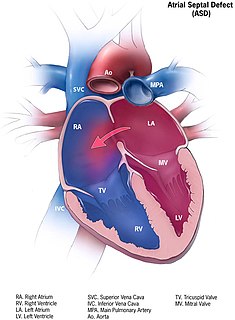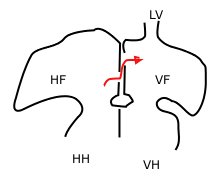Related Research Articles

Tetralogy of Fallot (TOF), formerly known as Steno-Fallot tetralogy, is a congenital heart defect characterized by four specific cardiac defects. Classically, the four defects are:

Atrial septal defect (ASD) is a congenital heart defect in which blood flows between the atria of the heart. Some flow is a normal condition both pre-birth and immediately post-birth via the foramen ovale; however, when this does not naturally close after birth it is referred to as a patent (open) foramen ovale (PFO). It is common in patients with a congenital atrial septal aneurysm (ASA).

Interventional cardiology is a branch of cardiology that deals specifically with the catheter based treatment of structural heart diseases. Andreas Gruentzig is considered the father of interventional cardiology after the development of angioplasty by interventional radiologist Charles Dotter.

A congenital heart defect (CHD), also known as a congenital heart anomaly and congenital heart disease, is a defect in the structure of the heart or great vessels that is present at birth. A congenital heart defect is classed as a cardiovascular disease. Signs and symptoms depend on the specific type of defect. Symptoms can vary from none to life-threatening. When present, symptoms may include rapid breathing, bluish skin (cyanosis), poor weight gain, and feeling tired. CHD does not cause chest pain. Most congenital heart defects are not associated with other diseases. A complication of CHD is heart failure.

A ventricular septal defect (VSD) is a defect in the ventricular septum, the wall dividing the left and right ventricles of the heart. The extent of the opening may vary from pin size to complete absence of the ventricular septum, creating one common ventricle. The ventricular septum consists of an inferior muscular and superior membranous portion and is extensively innervated with conducting cardiomyocytes.
Cor triatriatum is a congenital heart defect where the left atrium or right atrium is subdivided by a thin membrane, resulting in three atrial chambers.
The mini-maze procedures are cardiac surgery procedures intended to cure atrial fibrillation (AF), a common disturbance of heart rhythm. They are procedures derived from the original maze procedure developed by James Cox, MD.
The Dor procedure is a medical technique used as part of heart surgery and originally introduced by the French cardiac surgeon Vincent Dor (b.1932). It is also known as endoventricular circular patch plasty (EVCPP).

The foramen secundum, or ostium secundum is a foramen in the septum primum, a precursor to the interatrial septum of the human heart.
Septal myectomy is a cardiac surgery treatment for hypertrophic cardiomyopathy (HCM). The open-heart surgery entails removing a portion of the septum that is obstructing the flow of blood from the left ventricle to the aorta. Septal myectomies have been successfully performed since the 1960s. The most common alternatives to septal myectomies are treatment with medication or non-surgical thinning of tissue with alcohol ablation. Ordinarily, septal myectomies are performed only after attempts at treatment with medication fail. The choice between septal myectomy and alcohol ablation is a complex medical decision.
Alcohol septal ablation (ASA) is a percutaneous, minimally invasive procedure performed by an interventional cardiologist to relieve symptoms and improve functional status in eligible patients with severely symptomatic hypertrophic cardiomyopathy (HCM) who meet strict clinical, anatomic and physiologic selection criteria. In carefully selected patients, when performed by an experienced interventional cardiologist, the procedure is successful in relieving symptoms in over 90% of patients.

Lutembacher's syndrome is a very rare form of congenital heart disease that affects one of the chambers of the heart as well as a valve. It is commonly known as both congenital atrial septal defect (ASD) and acquired mitral stenosis (MS). Congenital atrial septal defect refers to a hole being in the septum or wall that separates the two atria; this condition is usually seen in fetuses and infants. Mitral stenosis refers to mitral valve leaflets sticking to each other making the opening for blood to pass from the atrium to the ventricles very small. With the valve being so small, blood has difficulty passing from the left atrium into the left ventricle. Septal defects that may occur with Lutembacher's syndrome include: Ostium primum atrial septal defect or ostium secundum which is more prevalent.
Sean Patrick Pinney is an American cardiologist and the Director of both the Advanced Heart Failure and Cardiac Transplant Program and the Pulmonary Hypertension Program at Mount Sinai Medical Center in New York City.
Annapoorna Kini is an American cardiologist. She is Professor of Cardiology and Interventional Director of Structural Heart Program at Mount Sinai School of Medicine in New York City.

Anomalous pulmonary venous connection is a congenital defect of the pulmonary veins.

Left atrial appendage occlusion (LAAO), also referred to as left atrial appendage closure (LAAC), is a treatment strategy to reduce the risk of left atrial appendage blood clots from entering the bloodstream and causing a stroke in patients with non-valvular atrial fibrillation (AF).
Jonathan L. Halperin is an American cardiologist and the author of Bypass (ISBN 0-89586-509-2), among the most comprehensive works on the subject of coronary artery bypass surgery. In addition, he is the Robert and Harriet Heilbrunn Professor of Medicine at The Mount Sinai School of Medicine as well as Director of Clinical Cardiology in the Zena and Michael A. Wierner Cardiovascular Institute at The Mount Sinai Medical Center, both in New York City. Halperin was the principal cardiologist responsible for both the design and execution of the multi-center Stroke Prevention in Atrial Fibrillation (SPAF) clinical trials, funded by the National Institutes of Health, which helped develop antithrombotic strategies to prevent stroke, and he subsequently directed the SPORTIF clinical trials, which evaluated the first oral direct thrombin inhibitor for prevention of stroke in patients with atrial fibrillation.
Ira S. Nash, is an American cardiologist.

Murray Stanley Hoffman was an American cardiologist, educator and diplomate of the American Board of Internal Medicine and the American Board of Cardiovascular Disease, a Fellow of the American College of Cardiology and a member of the Council on Clinical Cardiology (CLCD) of the American Heart Association.
Percutaneous pulmonary valve implantation (PPVI), also known as transcatheter pulmonary valve replacement (TPVR), is the replacement of the pulmonary valve via catheterization through a vein. It is a significantly less invasive procedure in comparison to open heart surgery and is commonly used to treat conditions such as pulmonary atresia.
References
- ↑ Katie Charles (January 20, 2011). "Congenital heart problems can be spotted even before birth". New York Daily News. Retrieved November 9, 2011.
- 1 2 "Mount Sinai School of Medicine - Barry A. Love" . Retrieved November 9, 2011.
- ↑ Spektor, Gary; Gehi, Anil K.; Love, Barry; Sharma, Samin K.; Fuster, Valentin (2006). "A case of symptomatic coronary artery fistula". Nature Clinical Practice Cardiovascular Medicine. 3 (12): 689–692. doi:10.1038/ncpcardio0709. PMID 17122802. S2CID 1522509.
- ↑ "Gregory M. Hirsch Hypertrophic Cardiomyopathy Center". Archived from the original on January 27, 2011. Retrieved November 9, 2011.
- ↑ "Castle Connolly Medical Ltd" . Retrieved November 9, 2011.
- ↑ "Super Doctors" . Retrieved November 9, 2011.
- ↑ "Hackensack University Medical Center". Archived from the original on December 15, 2010. Retrieved November 9, 2011.